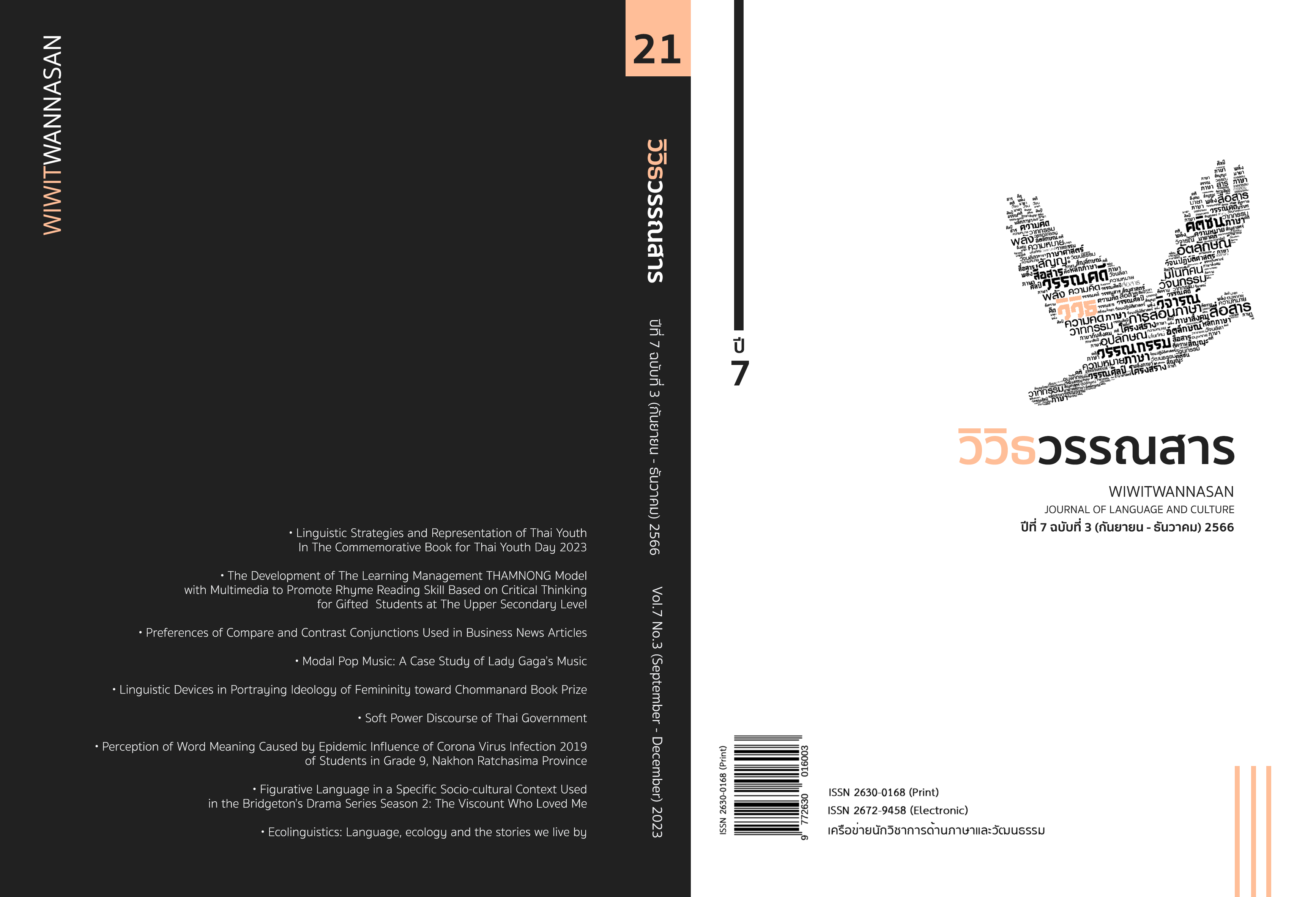ภาพพจน์ในบริบททางสังคมวัฒนธรรมที่จำเพาะในบทละครชุดบริดเจอร์ตัน ซีซั่น 2: ไวเคาต์ที่รักฉัน
Main Article Content
บทคัดย่อ
การวิจัยนี้มีวัตถุประสงค์เพื่อศึกษาภาพพจน์ในบริบททางสังคมวัฒนธรรมที่จำเพาะในละครชุดบริดเจอร์ตัน ซีซั่น 2: ไวเคาต์ที่รักฉัน และวิเคราะห์ความหมายภาพพจน์และจำแนกประเภทกลุ่มคำศัพท์ในบริบททางสังคมวัฒนธรรมที่จำเพาะในละครชุดบริดเจอร์ตัน ซีซั่น 2: ไวเคาต์ที่รักฉัน เป็นการศึกษาเชิงคุณภาพและใช้ข้อมูลเชิงปริมาณประกอบ ทั้งนี้ได้ศึกษาบทละครอเมริกันชุดสตรีมมิ่งเน็ต ฟลิกซ์ เรื่อง บริดเจอร์ตัน ซีซั่น 2 : ไวเคาต์ที่รักฉัน ที่เผยแพร่ตั้งแต่ เดือน มีนาคม 2565 การเลือกตัวอย่างใช้วิธีเจาะจง ตัวบทที่ใช้ศึกษาคือบทละครอเมริกันชุดสตรีมมิ่งเน็ตฟลิกซ์ (Netflix) เรื่อง บริดเจอร์ตัน ซีซั่น 2 : ไวเคาต์ที่รักฉัน ในรูปแบบภาษาอังกฤษจาก www.8FLiX.com ทั้งหมด 8 ตอนการจัดกลุ่มข้อมูลและดัชนีหัวข้อด้วยโปรแกรมคอมพิวเตอร์ การวิเคราะห์ข้อมูลเชิงพรรณนาวิเคราะห์ โดยใช้ค่าเฉลี่ยร้อยละ และการนำเสนอผลวิเคราะห์ข้อมูลในรูปแบบของตารางประกอบคำบรรยาย ผลการศึกษาพบว่า บทละครอเมริกันชุดสตรีมมิ่งเน็ตฟลิกซ์ เรื่อง บริดเจอร์ตัน ซีซั่น 2 : ไวเคาต์ ที่รักฉัน มีการเลือกใช้ภาพพจน์ ทั้งหมด 126 แห่ง โดยมีการใช้ภาพพจน์ ประเภทการแฝงนัย มากที่สุด จำนวน 37 แห่ง คิดเป็นร้อยละ 29.37 รองลงมาคือ อุปลักษณ์ จำนวน 29 แห่ง คิดเป็นร้อยละ 23.02 บุคลาธิษฐาน จำนวน 16 แห่ง คิดเป็นร้อยละ 12.70 และ อุปมา จำนวน 16 แห่ง คิดเป็นร้อยละ 12.70 ตามลำดับ ด้านการวิเคราะห์ความหมายพบจำนวนวลีและประโยคภาพพจน์ตามบริบททางสังคม ทั้งหมด 5 ด้าน ทางด้านสังคม คิดเป็นร้อยละ 57.14 ด้านวัตถุ คิดเป็นร้อยละ 17.46 ด้านนิเวศวิทยา คิดเป็นร้อยละ 13.49 ด้านศาสนา คิดเป็นร้อยละ 6.35 และ ด้านภาษาศาสตร์ คิดเป็นร้อยละ 5.56 ตามลำดับ
กล่าวโดยสรุป การวิจัยนี้ย้ำความสำคัญของภาพพจน์ในการเสริมความหลากหลายของเรื่องราวและการสะท้อนบริบททางสังคมวัฒนธรรมที่เป็นเอกลักษณ์ในละครชุด เรื่อง บริดเจอร์ตัน ซีซั่น 2 : ไวเคาต์ที่รักฉัน การใช้ภาพพจน์ช่วยเสริมสร้างความเชื่อมโยงอารมณ์ความรู้สึกจากตัวละครสู่ผู้ชมละครได้อย่างดีและเสริมองค์ความรู้ทางสังคมวัฒนธรรมจากละครชุดนี้ได้เว้น 10 pt.
Article Details

อนุญาตภายใต้เงื่อนไข Creative Commons Attribution-NonCommercial-NoDerivatives 4.0 International License.
ลิขสิทธิ์ของบทความเป็นของวารสาร การพิมพ์ซ้ำจะต้องได้ร้บการอนุญาตจากบรรณาธิการวารสาร
เอกสารอ้างอิง
Kubota, R. (2008). Critical approaches to teaching Japanese and culture. In J, Mori. & A. S. Ohta (Eds.). Japanese applied linguistics: Discourse and social perspective. Retrieved from https://www. cambridge.org/core/journals/languageteaching/article/review
Lakoff, G. & Johnson, M. (1980). Metaphors we live by. Chicago. University of Chicago Press.
Lakoff, R. (1973). Language and woman’s place. Language in Society, 2. 45-80.
Noibunsuk, T. & Webb, R.K. (2018). Metaphor Language in the context of social and cultural context : an analysis of musical theater Broadway: Sweeney Todd: The Dermon Barber of Fleet Street. Journal of Humanities and Social Sciences Rangsit University, 13, (2), 61-86. (In Thai)
Panakun, P. & Singhasenee, S. (2017). Introduction to British and American Literature (16th ed.) Bangkok: Ramkhamhaeng University Press. (In Thai)
Pinmanee, S. (2012). A wrong and Right Translation: Manual for Translation in Modern Age. Bangkok: Chulalongkorn University Press. (In Thai)
Rakmanee, S. (2008). A textbook on the course 361322: Literary Arts. Bangkok: Thai Department, Faculty of Humanities, Kasetsart University. (In Thai)
Rocanawit, P. & Panel, S. (2022). A translation of personification and oxymoron in Thai version of The Alchemist: a comparison of two translated versions. Journal of Social Research and Development, 4 (1), 45-62. (In Thai)
Samadhayakun, A. (2014). Contemporary Literature. Mahasarakham: Mahasarakham University Press. (In Thai)
Sonsomrit, R. & Kanlayanamit, S. (2019). A study of figure of speech in English headline in advertising media of western fast food appearing in Image Google website. Journal of Humanities, Naresuan University, 16 (1), 113-130. (In Thai)
Wangmanee, P. (2022). Awareness of the value and attitude towards the learning of literature in English of undergraduate students (International Program). Mangraisan Journal, 10 (1), 15-32. (In Thai)


